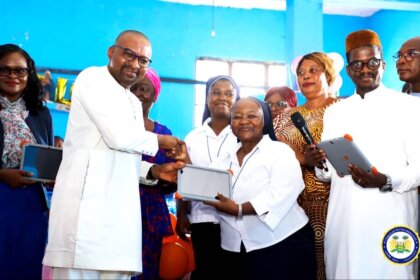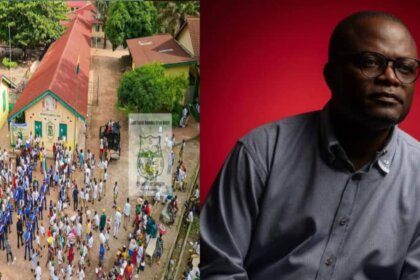The Bank of Sierra Leone has recently announced a hike in the Monetary Policy Rate (MPR) by 1.0 percentage point, increasing it to 22.25 percent.
The announcement was made in the recently published statement by the Bank of Sierra Leone after its Monetary Policy Committee (MPC) met on 14 December 2023. The meeting was chaired by the Governor, Dr. Ibrahim L. Stevens.
“Following an extensive review of recent global and domestic macroeconomic and financial market developments, and the implications for domestic inflation and growth, the MPC decided to raise the Monetary Policy Rate (MPR) by 1.0 percentage point to 22.25 percent.” The document reads.
It went on to explain the rationale behind the increase, stating several factors including: Global economic developments, inflation rates, domestic economic activities, fiscal development, as well as the state of money, banking, and financial system stability, that influenced the monetary stance.
Read below the overview of these significant considerations that informed the Committee’s decision on the stance of monetary policy as indicated in the document
“GLOBAL ECONOMIC DEVELOPMENTS
According to the October 2023 IMF World Economic Outlook, global growth is projected at 3.0 percent in 2023, down from 3.5 percent in 2022, and to moderate to 2.9 percent in 2024. Advanced economies continue to drive the decline in growth, especially in the Euro Area, with weaker manufacturing activities, which more than offset the stronger growth in the services sector, coupled with the impact of growing headwinds in China’s real estate sector. The situation is exacerbated by heightened geo-political tensions, economic fragmentation, and climate change risk, thereby slowing the pace of recovery in global growth.
The MPC notes that China’s real estate crisis could deteriorate further, posing risks for the global economy. Sierra Leone, being a key trading partner, potentially, could be impacted severely. Also, while global headline inflation has been trending downwards, it is still high by historical standards. Moreover, commodity prices remain volatile amid climate and geopolitical shocks, suggesting a major risk for global inflation. Further, global food supply could be disrupted by an escalation of the war in Ukraine, resulting in higher prices and economic distress for many low-income countries, including Sierra Leone.
Despite the foregoing, the MPC expects that the gradual normalization of supply chains and the decline in global inflation would lead to lower imported inflation, resulting in lower prices for imported goods.
INFLATION
Inflationary pressures have been persistently high since the last MPC. Inflation increased significantly from 44.98 percent in July to 50.94 percent in August 2023 and edged further to 54.48 percent in September 2023, reflecting the upward adjustment of domestic fuel prices. However, inflation rose marginally to 54.59 percent in October 2023 and thereafter declined to 54.20 percent in November 2023. The easing of inflationary pressures could be attributed to the tight monetary policy stance adopted by the BSL to bring down inflation. The MPC notes that the receding global inflation, coupled with efforts by the government to enhance the supply of food and other essential commodities, as well as the relative stability in the exchange rate, could help to further moderate inflationary pressures in the near-term.
DOMESTIC ECONOMIC ACTIVITIES
The domestic economy continues to face challenges due to both global and domestic factors. These include domestic supply shocks, lower-than-expected output from key productive sectors, such as agriculture and mining, and the lingering uncertainty in the global environment. Consequently, domestic activity is estimated to grow by 2.7 percent in 2023 compared to 3.5 percent in 2022. Also, the BSL’s Composite Index of Economic Activities (CIEA) indicates a slowdown in economic activity in 2023Q3, compared to the growth observed in 2023Q2.
However, given the government’s initiative to implement various sectoral reforms, including, for example, The Feed Salone Programme, to ensure increased agricultural productivity and inclusive economic growth, the MPC is of the view that the economy will be resilient over the medium-term to long-term.
The trade deficit widened by 40.43 percent to US$240.44mn in 2023Q3, from US$171.21mn in 2023Q2, reflecting a reduction in export receipts, which more than outweighed the decrease in the import bill. The gross foreign exchange reserves of the Bank of Sierra Leone decreased to an equivalent of 2.3 months of import cover in 2023Q3, from 2.8 months of import cover in 2023Q2, mainly on account of excess outflows over inflows. The depreciation of the Leone moderated, reflecting the positive impact of policy actions taken by the BSL to remove bottlenecks in the foreign exchange markets, including the removal of administrative barriers, the amendment of the BSL Act 2019, to permit the use of currencies other than the Leone in selected transactions in Sierra Leone, and the announcement effect of the decision to permit lending in foreign currency by commercial banks, on a case-by-case basis.
Further, the pressure on the gross foreign exchange reserves is explained by the lower-than- expected inflows from key foreign exchange earning sectors, debt service payments and payments for essential goods and services. However, the MPC is of the view that expected official inflows and private transfers, as well policy measures by the government to support the productive sectors of the economy, would help to boost the gross external reserve position in the coming year.
FISCAL DEVELOPMENTS
Fiscal policy was expansionary in 2023Q3. There was an increase in the overall fiscal deficit relative to 2023Q2, reflecting the increase in Government expenditure, which outweighed the increase in revenue. The primary balance also deteriorated, owing to the overruns in non-salary- non-interest spending and the wage bill, among others. These factors notwithstanding, the MPC noted the Government’s commitment to implement a mix of revenue enhancement and expenditure containment measures to achieve a budget deficit of 5.8 percent of GDP in 2023, as agreed with the IMF.
MONEY AND BANKING
Reserve Money (RM) and Broad Money (M2) increased in 2023Q3. The growth in RM was driven by Net Domestic Asset (NDA) of the BSL, while growth in Broad Money (M2) was on account of the increase in the NDA of the Banking System. The increase in NDA of both the BSL and the banking system was in part due to secondary market operations conducted by the BSL to support market liquidity..
Meanwhile, growth in commercial bank credit to the private sector decreased further, an obvious constraint to economic growth. Additionally, the MPC is concerned that credit to the private sector is skewed to only a few sectors, namely, commerce and finance, construction, business, and personal services. Commercial banks are encouraged to extend credit to productive sectors such as agriculture, which has the potential to stimulate growth in the real economy.
FINANCIAL SYSTEM STABILITY
The banking sector was relatively stable over the review period. Most of the key Financial Soundness Indicators (FSIs) were within acceptable thresholds, despite current macroeconomic challenges. However, the level of Non-Performing Loans (NPLs) exceeded the tolerable limit, posing a risk to financial system stability. Also, the reliance on investment in T-Bills could adversely affect the profitability of commercial banks in the event of an unexpected fall in the T- Bill rate.
CONCLUSION
Inflationary pressures persisted in 2023Q3, mainly due to imported inflation, domestic food supply shocks and the adjustment in fuel prices. Overall, the risks to the inflation outlook are largely tilted to the upside. Therefore, the Bank is committed to maintaining a tight monetary policy stance in subsequent quarters to address inflationary pressures, which should be supported by prudent fiscal policy.
The MPC also discussed the potential impact of the recent failed coup plot of 26 November 2023 on the domestic economy, especially the ensuing macroeconomic uncertainty. Consequently, mindful of the objective to maintain price and financial system stability while also supporting investment and growth, the MPC decided to raise the MPR by 1.0 percentage point to 22.25 percent and to adjust the Standing Lending Facility and Standing Deposit Facility rates by the same margin.
Therefore, effective Monday, 18 December 2023, the following rates are published for the information of the public:
Monetary Policy Rate (MPR): 22.25 percent
Standing Lending Facility Rate (SLFR): 25.25 percent
Standing Deposit Facility Rate (SDFR): 15.75 percent
The MPC will continue to monitor developments in the global and domestic economy and stands ready to take appropriate action as may be required to maintain price and financial system stability.”

















